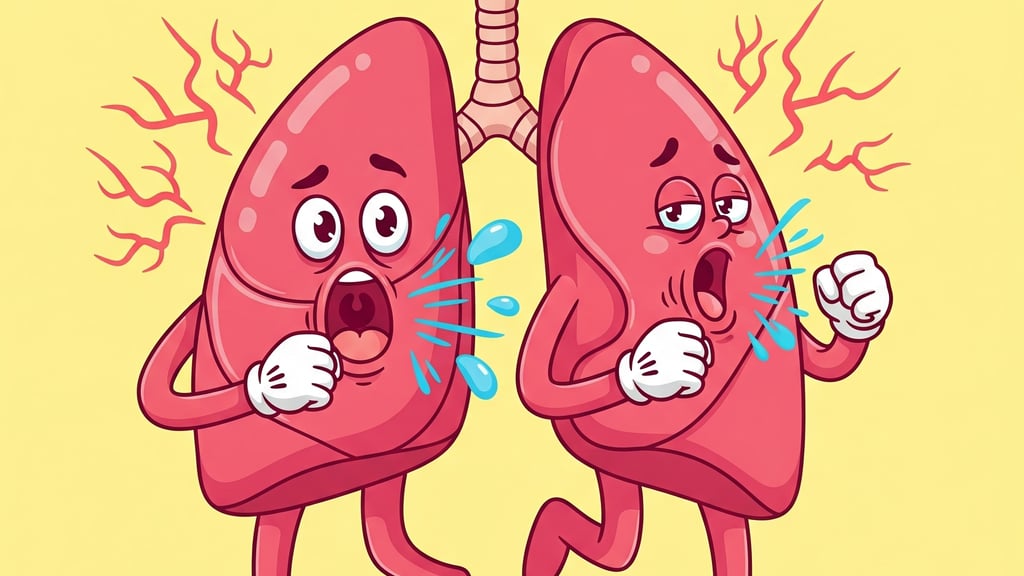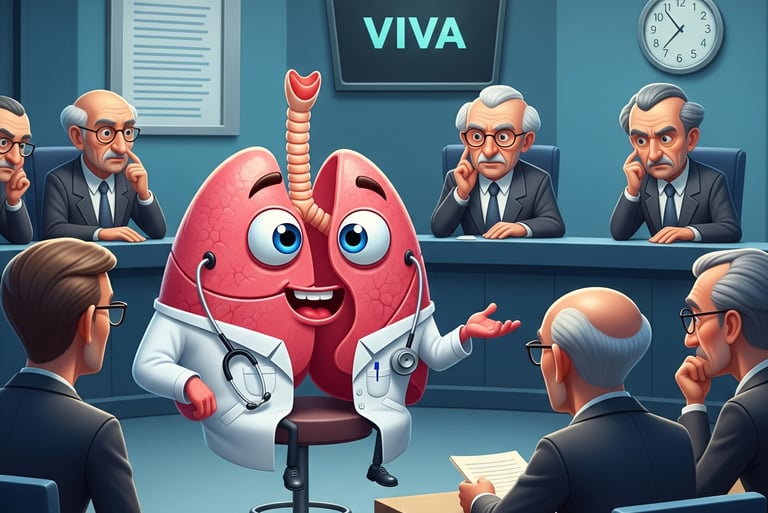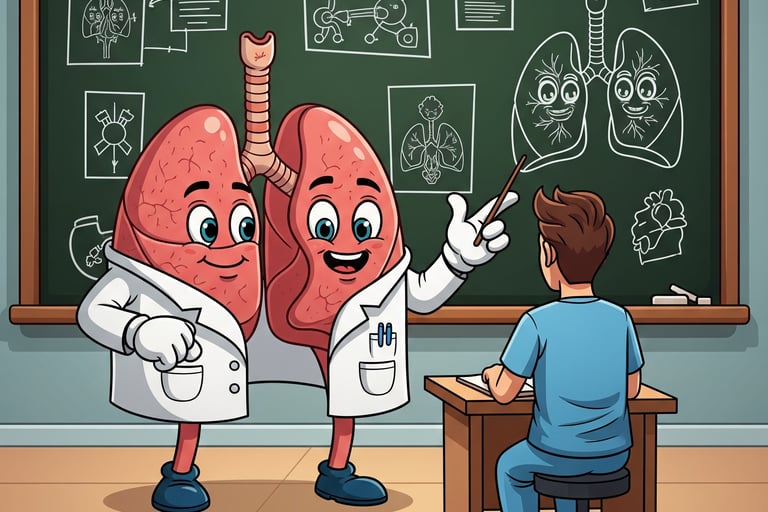THEMEDPRACTICALEXAM.COM


Approach to a patient with cough
1. Patient Demographics and Presenting Complaint
Begin with the patient’s age, gender, and main complaint: “What brings you in today?”
Confirm and clarify the symptom: “Can you tell me more about your cough?”
2. History of Presenting Illness
Onset: When did the cough start? Was the onset sudden or gradual?
Duration: How long have you had the cough (acute: <3 weeks, subacute: 3-8 weeks, chronic: >8 weeks)?
Character: Is it dry or productive? If productive, describe the sputum (color, amount, odor, presence of blood).
Timing: Is the cough worse at any particular time (e.g., night, early morning)?
Pattern/Progression: Has it changed over time or remained the same?
Aggravating/Relieving Factors: What makes it worse or better (e.g., lying down, exposure to dust, exertion)?
Associated Symptoms: Ask about fever, breathlessness, chest pain, wheeze, hemoptysis, nasal symptoms, heartburn, weight loss, night sweats.
Review of Systems
Systematically ask about symptoms in other systems to rule out extrapulmonary causes (e.g., reflux, cardiac symptoms, systemic features like weight loss or night sweats).
3. Past Medical History
Ask about previous respiratory illnesses (asthma, COPD, tuberculosis, pneumonia, bronchiectasis).
Inquire about other chronic illnesses (diabetes, heart disease, GERD, immunosuppression).
4. Family History
Inquire about family history of respiratory diseases (asthma, tuberculosis, lung cancer), autoimmune diseases, or other
6. Personal History
Smoking: Type, amount, duration (calculate pack-years).
Alcohol and Substance Use: Frequency and type.
Occupation: Exposure to dust, chemicals, animals, asbestos, or infectious diseases.
Travel/Recent Contacts: Exposure to tuberculosis or other infectious diseases.
Allergy History
Ask about known allergies and reactions, especially to drugs or environmental triggers.
relevant conditions.
Drug History
List all current medications, including over-the-counter and herbal remedies.
Specifically ask about ACE inhibitors, beta-blockers, and other drugs known to cause cough or pulmonary side effects.
Any recent medication changes
7. Socioeconomic History
Living Conditions: Crowding, exposure to allergens, pets, passive smoking, use of biomass fuels.


Now, let’s explore a case presented in the structured format outlined above
Name: Mr. Ramesh Kumar
Age: 52 years
Occupation: Shopkeeper
Presenting Complaint:
Mr. Kumar presents with a complaint of cough for the past 3 weeks.
History of Present Illness:
The cough began insidiously and has gradually worsened over the past three weeks. It is present throughout the day and disturbs his sleep at night. The cough is productive, with yellowish sputum, about a teaspoonful each time, and occasionally streaked with blood. He denies any foul odor. He also reports low-grade fever, malaise, and loss of appetite. There is no history of breathlessness, chest pain, or wheezing. He denies any recent travel or contact with tuberculosis patients.
(Aggravating and Relieving Factors:)
The cough worsens in the early morning and after exposure to dust in his shop. It is not relieved by over-the-counter cough syrups.
(Associated Symptoms:)
He has experienced mild weight loss and night sweats over the past month. No history of heartburn, nasal congestion, or postnasal drip.
Past Medical History:
No history of asthma, COPD, or previous tuberculosis. No known diabetes or hypertension. No previous hospitalizations or surgeries.
Family History:
No family history of asthma, tuberculosis, or lung cancer. Father was hypertensive, mother is healthy.
Personal HIstory
He has been smoking 10 cigarettes per day for the past 25 years (12.5 pack-years). No alcohol or illicit drug use. Works in a dusty environment as a shopkeeper.
Drug History:
Not on any regular medications. No recent use of ACE inhibitors or other drugs known to cause cough. No known drug allergies.
Socioeconomic History
Lives with his wife and two children in a well-ventilated house. No pets at home.
Summary:
Mr. Ramesh Kumar, a 52-year-old shopkeeper and chronic smoker, presents with a subacute productive cough, low-grade fever, mild hemoptysis, weight loss, and night sweats. The history raises suspicion for pulmonary tuberculosis or a chronic respiratory infection, and further evaluation is warranted


Here are some commonly asked viva questions based on the above topic.
1. How do you define acute, subacute, and chronic cough?
Acute cough lasts less than 3 weeks, subacute cough lasts 3–8 weeks, and chronic cough persists for more than 8 weeks.
2. What are the key points to elicit in the history of a patient with cough?
Onset, duration, character (dry or productive), sputum details (color, quantity, odor, blood), aggravating and relieving factors, associated symptoms (fever, breathlessness, chest pain, hemoptysis, weight loss, night sweats), past medical history, drug history, family history, smoking, and occupational exposure.
3. What are the common causes of chronic cough?
Chronic bronchitis (COPD), bronchiectasis, pulmonary tuberculosis, asthma, postnasal drip, gastroesophageal reflux disease (GERD), lung cancer, and drug-induced cough (e.g., ACE inhibitors).
4. What is the significance of hemoptysis in a patient with cough?
Hemoptysis is a red flag symptom and may indicate serious conditions like pulmonary tuberculosis, bronchiectasis, or lung cancer.
5. How does the character and color of sputum help in diagnosis?
Purulent, colored sputum suggests bacterial infection; blood-stained sputum may indicate tuberculosis or malignancy; foul-smelling sputum suggests anaerobic infection.
6. What are the red flag symptoms associated with cough?
Hemoptysis, significant weight loss, night sweats, persistent fever, and severe breathlessness.
7. What initial investigations would you order for a patient with chronic productive cough?
Sputum examination (for AFB, culture), chest X-ray, complete blood count, ESR/CRP, and, if indicated, CT chest.
8. How does smoking contribute to chronic cough?
Smoking damages the respiratory epithelium, impairs mucociliary clearance, increases mucus production, and predisposes to infections, COPD, and malignancy.
9. What is the physiological basis of cough?
Cough is a protective reflex triggered by stimulation of sensory receptors in the respiratory tract, leading to forceful expulsion of air to clear irritants, mucus, or pathogens.
10. How would you approach the management of a patient with suspected pulmonary tuberculosis?
Isolate the patient, confirm diagnosis with sputum AFB and chest X-ray, start anti-tubercular therapy, notify public health authorities, and counsel on infection control.


More detailed viva questions and answers
11. Question: Define cough and explain the detailed physiological mechanism of cough production.
Answer:
Definition: Cough is a sudden, often repetitive, spasmodic contraction of the thoracic cavity, resulting in a violent release of air from the lungs, usually accompanied by a characteristic sound. It is a vital protective reflex that clears the tracheobronchial tree of secretions and foreign material.
Mechanism: The cough reflex is a complex neurophysiological event involving five components:
Afferent Pathway: Irritant receptors (rapidly adapting receptors, C-fibers) located throughout the respiratory tract (larynx, trachea, large bronchi, distal airways, and even non-pulmonary sites like pleura, pericardium, diaphragm, esophagus, stomach) are stimulated by mechanical (e.g., foreign body, mucus) or chemical (e.g., smoke, inflammatory mediators) stimuli. These signals are transmitted via afferent nerves (mainly vagus, but also phrenic, trigeminal, glossopharyngeal) to the cough center in the brainstem.
Cough Center: Located in the medulla oblongata (specifically, the nucleus tractus solitarius), this central integrating center receives afferent input and coordinates the efferent response.
Efferent Pathway: Signals are sent from the cough center via efferent nerves (vagus, phrenic, and spinal motor nerves) to the diaphragm, abdominal muscles, intercostal muscles, and laryngeal muscles.
Motor Response (Three Phases):
Inspiratory Phase: A rapid, deep inspiration (0.5-2 liters of air) occurs, providing sufficient air volume for effective expulsion.
Compressive Phase: The glottis rapidly closes, and the expiratory muscles (intercostals and abdominal muscles) contract forcibly against the closed glottis. This leads to a rapid and significant buildup of intrathoracic pressure (up to 300 mmHg) and high transmural pressure across the airway walls.
Expiratory Phase: The glottis suddenly opens, resulting in an explosive release of air at high velocity (up to 500 mph or 800 km/h). This high velocity airflow generates strong shearing forces that dislodge mucus, foreign particles, and irritants from the airway walls, propelling them upwards for expectoration or swallowing.
12. Question: How do you classify cough based on duration, etiology, and expectoration?
Answer:
Based on Duration:
Acute Cough: Lasts for less than 3 weeks. Commonly due to viral upper respiratory tract infections (URTIs), acute bronchitis, pneumonia, or allergic rhinitis.
Subacute Cough: Lasts between 3 to 8 weeks. Often post-infectious (e.g., post-viral bronchitis) or due to bacterial sinusitis.
Chronic Cough: Lasts for more than 8 weeks. Requires thorough investigation for underlying causes.
Based on Etiology:
Specific Cough: A cough for which a clear underlying cause is identified and can be specifically treated (e.g., cough due to pneumonia, asthma exacerbation, GERD).
Non-specific Cough: A cough without an obvious underlying cause despite initial investigations, often managed symptomatically (less common now with better diagnostic tools).
Based on Expectoration:
Productive (Wet) Cough: Associated with the production of sputum (phlegm). Indicates the presence of secretions in the tracheobronchial tree.
Non-productive (Dry) Cough: Not associated with sputum production. Often irritative, commonly seen in viral infections, GERD, asthma, or ACE inhibitor use.
13. Question: Enumerate the common causes of chronic cough with a normal chest X-ray in a non-smoking patient not on ACE inhibitors.
Answer: In non-smoking patients not on ACE inhibitors, the "Big 3" causes account for over 90% of chronic cough with a normal chest X-ray:
Upper Airway Cough Syndrome (UACS) / Postnasal Drip Syndrome (PNDS): Caused by conditions like allergic rhinitis, perennial non-allergic rhinitis, or sinusitis, leading to mucus dripping down the posterior pharynx, irritating cough receptors.
Asthma (including Cough-Variant Asthma - CVA): CVA presents solely with chronic cough without other typical asthma symptoms like wheezing or dyspnea. Diagnosed by bronchial provocation tests (e.g., methacholine challenge).
Gastroesophageal Reflux Disease (GERD): Can cause cough through microaspiration of gastric contents into the tracheobronchial tree or vagal reflex stimulation by esophageal acid exposure. Other important causes to consider:
Non-asthmatic Eosinophilic Bronchitis (NAEB): Characterized by eosinophilic inflammation of the airways without bronchial hyperresponsiveness or variable airflow obstruction.
Post-infectious cough: A persistent cough following an acute viral or bacterial respiratory infection, often resolving spontaneously over time.
Bronchiectasis: While often associated with abnormal CXR, mild cases or early bronchiectasis can present with chronic cough and a seemingly normal CXR, requiring HRCT chest for diagnosis.
Psychogenic cough / Habit cough: A diagnosis of exclusion, often characterized by a repetitive, honking cough that disappears during sleep.
14. Question: Describe different types of cough based on their sound or characteristic, and list some common non-cardiac causes of cough.
Answer:
Types of Cough (by characteristic):
Brassy / Barking / Croupy Cough: A loud, harsh, metallic-sounding cough. Suggests laryngeal or tracheal pathology, such as tracheomalacia, tumor compressing the trachea, or croup (laryngotracheobronchitis) in children.
Bovine Cough: A low-pitched, hoarse, 'honking' or 'bovine' sound. Occurs due to paralysis or paresis of a vocal cord, typically from recurrent laryngeal nerve palsy (e.g., due to mediastinal tumor, aortic aneurysm, enlarged left atrium). Lack of glottic closure prevents effective cough.
Hacking / Ticklish Cough: Frequent, dry, short bursts of cough. Often associated with viral infections, early stages of asthma, GERD, or psychogenic cough.
Paroxysmal Cough: Sudden, violent, uncontrollable bouts of coughing, often ending in vomiting or a gasp. Characteristic of pertussis (whooping cough), foreign body aspiration, bronchial asthma, or severe postnasal drip.
Whooping Cough: A distinctive inspiratory "whoop" (high-pitched gasping sound) that follows a prolonged paroxysm of cough. Pathognomonic for pertussis (caused by Bordetella pertussis).
Non-Cardiac Causes of Cough: (Many overlap with chronic cough causes, but specifically excludes heart conditions)
Upper Airway Cough Syndrome (PNDS)
Asthma (including cough-variant asthma)
Gastroesophageal Reflux Disease (GERD)
ACE inhibitor-induced cough
Chronic bronchitis (especially in smokers, COPD)
Bronchiectasis
Post-infectious cough
Environmental irritants (e.g., smoke, dust)
Lung cancer (endobronchial lesions, mediastinal compression)
Interstitial lung disease (e.g., IPF, sarcoidosis)
Foreign body aspiration
Psychogenic cough
Pleural irritation (e.g., pleurisy)
Diaphragmatic irritation (e.g., subphrenic abscess)
Ear conditions (e.g., cerumen impaction, otitis media stimulating auricular branch of vagus nerve – Arnold's nerve reflex)
15. Question: How do you classify expectoration (sputum) based on quantity, quality (appearance/color), and odour?
Answer:
Quantity:
Scanty: Less than 10 ml/day (e.g., early viral bronchitis, early pneumonia).
Moderate: 10-50 ml/day.
Copious: More than 50 ml/day (e.g., bronchiectasis, lung abscess, bronchoalveolar carcinoma).
Quality (Appearance/Color):
Mucoid (Clear/White): Excess mucus; seen in viral infections, asthma, chronic bronchitis, pulmonary edema (thin, watery).
Purulent (Yellow/Green): Contains neutrophils; indicates bacterial infection (e.g., bacterial bronchitis, pneumonia, bronchiectasis). Green color is due to the enzyme verdoperoxidase released by neutrophils.
Rusty (Reddish-brown): Due to old, hemolyzed blood; classically associated with Streptococcus pneumoniae pneumonia (Lobar pneumonia).
Pink Frothy: Classically seen in acute pulmonary edema due to left ventricular failure.
Anchovy Sauce/Chocolate Sauce: Thick, reddish-brown, often odorless; characteristic of amoebic liver abscess that has ruptured into the lung.
Black/Grey (Melanoptysis): Contains carbon particles or melanin; seen in coal worker's pneumoconiosis, heavy smokers, or anthracosis.
Yellowish with Sulfur Granules: Suggestive of Actinomycosis.
Cheesy/Caseous: Thick, whitish, cottage-cheese-like; associated with tuberculosis or certain fungal infections.
Odour:
Fetid/Foul-smelling: Indicates anaerobic bacterial infection (e.g., lung abscess, putrid bronchiectasis, empyema).
Odorless: Most common.
16. Question: What is 3-layered sputum, what are its causes, and what are the causes of postural variation of sputum?
Answer:
3-Layered Sputum: This refers to sputum that, when collected in a clear glass container and allowed to stand undisturbed for some time (e.g., a few hours), separates into three distinct layers:
Top Layer: Frothy, containing air bubbles and mucus.
Middle Layer: Turbid or greenish fluid, consisting of saliva, pus, and cellular debris.
Bottom Layer: A thick, opaque, purulent deposit of necrotic tissue and cellular material.
Causes of 3-Layered Sputum: It is typically seen in chronic suppurative lung diseases involving large cavities or dilated bronchi where secretions collect and stratify due to gravity:
Bronchiectasis (especially cystic or saccular bronchiectasis)
Lung abscess
Chronic empyema (if it drains into a bronchus)
Causes of Postural Variation of Sputum: This phenomenon describes a significant increase in the quantity of sputum produced when the patient changes position (e.g., waking up from sleep, lying down on a different side, or performing specific postural drainage maneuvers). It occurs when secretions accumulate in a dilated airway or cavity and are then released by gravity with a change in position.
Causes:
Bronchiectasis (most common cause)
Lung abscess
Cystic fibrosis
Empyema draining into a bronchus
17. Question: Define hemoptysis and list its major causes.
Answer:
Definition: Hemoptysis is the coughing up of blood from the lower respiratory tract (trachea, bronchi, or lung parenchyma).
Major Causes: Hemoptysis can be broadly categorized based on the source of bleeding:
Bronchial/Airway Causes (most common source, ~90% of cases):
Infections:
Bronchitis: Acute or chronic bronchitis (most common cause of mild hemoptysis).
Bronchiectasis: Especially cystic bronchiectasis, due to inflamed and dilated airways.
Tuberculosis (TB): Active cavitary TB is a major cause of hemoptysis, including massive hemoptysis, globally.
Lung Abscess: Necrotizing infection.
Fungal Infections: Aspergilloma (fungus ball within a pre-existing cavity) is a common cause of recurrent hemoptysis.
Pneumonia (e.g., Klebsiella, S. pneumoniae).
Malignancy:
Bronchogenic Carcinoma: Especially squamous cell carcinoma and adenocarcinoma.
Bronchial adenoma.
Inflammatory:
Vasculitis (e.g., Granulomatosis with Polyangiitis, Microscopic Polyangiitis).
Parenchymal Causes:
Trauma: Chest trauma, iatrogenic (e.g., post-bronchoscopy biopsy, lung biopsy).
Alveolar Hemorrhage Syndromes: Diffuse alveolar hemorrhage due to conditions like Goodpasture's syndrome, Granulomatosis with Polyangiitis, Systemic Lupus Erythematosus (SLE), Idiopathic pulmonary hemosiderosis.
Pulmonary Infarction: Due to pulmonary embolism.
Vascular Causes:
Pulmonary Embolism (PE) with Infarction: Bleeding from necrotic lung tissue.
Arteriovenous Malformations (AVMs): Congenital or acquired abnormal connections between arteries and veins.
Mitral Stenosis: Rupture of congested bronchial veins.
Pulmonary hypertension.
Other Rare Causes:
Endometriosis (Catamenial hemoptysis).
Foreign body aspiration.
Coagulopathies or anticoagulant use.
18. Question: Differentiate between true hemoptysis and false hemoptysis, and between hemoptysis and hematemesis.
Answer:
When a patient presents with blood from their mouth, it's crucial to differentiate its origin. Let's break down the distinctions:
Differentiating True Hemoptysis from False Hemoptysis
True Hemoptysis refers to blood that genuinely originates from the lower respiratory tract—the larynx, trachea, bronchi, or lung parenchyma. You'll recognize it by its bright red, frothy appearance, often mixed with sputum, indicating it's been aerated in the lungs. It tends to have an alkaline pH because of the respiratory secretions. Patients typically report a cough or a tickling sensation in their throat preceding the blood, and it's often accompanied by symptoms of underlying lung disease like dyspnea or chest pain.
In contrast, False Hemoptysis, or pseudohemoptysis, is blood that appears to be coughed up but actually comes from a source outside the lower respiratory tract. This could be from the nasopharynx, oral cavity, or even the gastrointestinal tract. The blood usually appears darker, clotted, and lacks frothing. Its pH can be variable; for example, it might be alkaline if from nasal bleeding or acidic if from a gastric source. Instead of a cough, it might be preceded by a nosebleed, gum bleeding, or if from the GI tract, vomiting. Associated symptoms would relate to the actual source, such as oral discomfort or nasal congestion.
Differentiating Hemoptysis from Hematemesis
This distinction is vital for immediate management, as they point to entirely different systems.
Hemoptysis is the coughing up of blood from the lungs or bronchial tree.
It's typically preceded by a cough or a feeling of tickle in the throat.
The blood itself is usually bright red and frothy, mixed with sputum, and has an alkaline pH.
Patients often report associated respiratory symptoms like shortness of breath or chest discomfort.
After the initial episode, they might continue to cough up blood-tinged sputum.
Hematemesis, on the other hand, is the vomiting of blood from the gastrointestinal tract, specifically from the stomach or esophagus.
It's generally preceded by nausea, retching, or abdominal discomfort.
The vomited blood is typically dark red, has a "coffee-ground" appearance (due to the action of gastric acid on hemoglobin), and is often mixed with food particles. It will have an acidic pH.
Associated symptoms are usually gastrointestinal, such as indigestion, difficulty swallowing, or signs of hypovolemia.
Crucially, hematemesis is often followed by melena (black, tarry stools) within hours, as the digested blood passes through the intestines.
Understanding these key differences in presentation, associated symptoms, and characteristics of the blood itself is paramount for accurate diagnosis and appropriate management in an emergency setting.
19. Question: Define massive hemoptysis and list its common causes.
Answer:
Definition of Massive Hemoptysis: Massive hemoptysis (also termed life-threatening hemoptysis) is generally defined as:
Coughing up a large quantity of blood, typically greater than 100-200 ml in 24 hours (some definitions use >600 ml in 24 hours, but smaller amounts can be life-threatening).
Any amount of hemoptysis that causes hemodynamic instability (e.g., hypotension, tachycardia, shock) or respiratory compromise (e.g., dyspnea, hypoxia, aspiration), regardless of the actual volume.
Any amount of blood that poses a significant threat to the airway due to the risk of asphyxiation from aspiration.
Common Causes of Massive Hemoptysis:
Tuberculosis (TB): Especially active cavitary TB, rupture of Rasmussen's aneurysm (dilated pulmonary artery branch within a TB cavity), or post-TB bronchiectasis.
Bronchiectasis: Particularly cystic or saccular bronchiectasis, where inflamed, dilated airways are prone to bleeding from hypertrophied bronchial arteries.
Aspergilloma: A fungal ball (Aspergillus species) within a pre-existing lung cavity (often post-TB), eroding into blood vessels.
Lung Cancer: Especially squamous cell carcinoma, which tends to cavitate and erode into vessels.
Lung Abscess: Necrotizing infection leading to erosion of blood vessels.
Pulmonary Arteriovenous Malformation (AVM): Congenital or acquired abnormal vascular connections that can rupture.
Trauma: Severe chest trauma, iatrogenic injury (e.g., during procedures).
20. Question: What are the common complications of chronic or severe coughing?
Answer: Severe or chronic coughing, though a protective reflex, can lead to various complications:
Musculoskeletal:
Chest wall pain, muscle strain (intercostal, abdominal).
Rib fractures (especially in elderly or osteoporotic patients).
Costochondritis.
Rectus sheath hematoma.
Neurological/Cardiovascular:
Cough Syncope (Tussive Syncope): Transient loss of consciousness due to reduced cerebral blood flow from increased intrathoracic pressure, impeding venous return and cardiac output.
Subarachnoid hemorrhage (rare, in predisposed individuals).
Peripheral venous pressure elevation (causing venous distension in neck, face).
Respiratory:
Pneumothorax, pneumomediastinum (due to high intrathoracic pressure).
Bronchospasm (especially in asthmatics).
Vocal cord dysfunction/hoarseness.
Exacerbation of underlying lung disease.
Gastrointestinal:
Hernias (inguinal, umbilical, hiatal – due to increased intra-abdominal pressure).
Gastroesophageal reflux.
Rectal prolapse.
Other:
Fatigue, exhaustion, insomnia.
Urinary incontinence (especially stress incontinence in women).
Subconjunctival hemorrhage, petechiae on face/neck (due to transient venous hypertension).
Rupture of surgical wounds.
Anxiety, depression, social embarrassment.
21. Question: What are the "red flag" symptoms associated with cough or hemoptysis that warrant urgent investigation in an MD General Medicine setting?
Answer: "Red flag" symptoms associated with cough or hemoptysis indicate potentially serious underlying pathology requiring prompt and thorough investigation:
Hemoptysis: Any amount of hemoptysis, especially if recurrent, increasing in volume, or associated with other systemic symptoms.
Weight Loss: Unexplained and significant weight loss.
Anorexia/Loss of Appetite: Persistent loss of appetite.
Fever: Persistent or recurrent unexplained fever.
Night Sweats: Excessive sweating during sleep.
Dyspnea (Shortness of Breath): New onset or worsening dyspnea accompanying cough.
Chest Pain: Persistent or pleuritic chest pain.
New Onset Cough in a Smoker/Ex-smoker: Highly suspicious for malignancy.
Change in Character of Chronic Cough: Any significant change in a long-standing cough (e.g., becoming productive, change in sound).
Hoarseness (New Onset/Persistent): Suggestive of laryngeal pathology or recurrent laryngeal nerve involvement.
Recurrent Pneumonia in the Same Lobe: Raises suspicion for underlying bronchial obstruction (e.g., tumor, foreign body).
Abnormal Chest X-ray Findings: Any suspicious findings like a mass, nodule, persistent infiltrate, or effusions.
Clubbing: Digital clubbing, often associated with chronic lung diseases (e.g., bronchiectasis, lung cancer, IPF).
Persistent or Worsening Cough: Despite appropriate initial treatment.
Immunosuppression: Cough in an immunocompromised patient (e.g., HIV, transplant recipient) warrants urgent evaluation.